Meluhha hieroglyphs of Gudimallam sculpture, kole.l'smithy' is kole.l'temple' (Kota). A continuum of metalwork traditions of Sarasvati-Sindhu civilization.
Gudimallam temple and sculpture of linga are an early example of a smithy metaphored as a temple consistent with the Meluhha hieroglyph: kole.l'smithy' Rebus: kole.l 'temple' (Kota). This early conception of the temple is evidenced at Gudimallam ca. 3rd century BCE.
The remarkable feature of the sculptural motifs on the temple are a continuum of Meluhha hieroglyphs: safflower, elephant, ram, tabor or drum, goblin (gaNa metaphored by 'elephant legs' on the Gudimallam sculpture), oxhide ingot (depicted on Indus writing of Mohenjodaro tablet m1429 showing oxhide ingot cargo on a boat).
All these hieroglyphs gleaned from Gudimallam sculpture are related to metalwork and are a reaffirmation that a smithy was a temple. It is not mere coincidence that Rigveda refers to Bharatam Janam validating their identity as metal casters: bharat'alloy of copper, pewter, tin' (Marathi); bharatiyo'metal casters' (Gujarati). The gloss bharata 'metal caster' was rendered by the hieroglyph barad'bull'. Thus, Meluhha metalworkers were Bharatam Janam blessed by Rishi Viswamitra in the Rigveda. So does Gudimallam evidence a continuum of Siva linga tradition of Sarasvati-Sindhu civilization.
Rebus readings of the hieroglyphs related to metalwork are:
Hieroglyph: karaḍa -- m. ʻsafflowerʼ, °ḍā -- f. ʻ a tree like the karañja ʼ (Prakrit); M. karḍī, °ḍaī f. ʻ safflower, carthamus tinctorius and its seed ʼ. (CDIAL 2788). Rebus: करडा [karaḍā] Hard from alloy--iron, silver &c. (Marathi) kharādī ' turner, a person who fashions or shapes objects on a lathe' (Gujarati)
Hieroglyph: miṇḍāl 'markhor' (Tōrwālī) meḍho a ram, a sheep (Gujarati)(CDIAL 10120) Rebus: mẽṛhẽt, meḍ 'iron' (Munda.Ho.) mr̤eka, melh 'goat' (Telugu. Brahui) Rebus: melukkha 'milakkha, copper'. If the animal carried on the right hand of the Gudimallam hunter is an antelope, the possible readings are: ranku 'antelope' Rebus: ranku 'tin'.
Hieroglyph: ibha 'elephant' Rebus: ib 'iron' (Santali)[ 'Elephant legs' on gaNa are an evocation of this rebus reading ibha 'elephant' Rebus: ib 'iron'. Hence, the hieroglyph of gaNapati with elephant face to denote leader of guild of (iron)metalworkers.]
Hieroglyph: ḍaṅkɔ m. ʻ large kettledrum ʼ Rebus: ḍāṅro 'blacksmith' (Nepali)
Hieroglyph: ढाल [ ḍhāla ] f (S through H) The grand flag of an army directing its march and encampments: also the standard or banner of a chieftain: also a flag flying on forts &c. ढालकाठी [ ḍhālakāṭhī ] f ढालखांब m A flagstaff. (Paras'u?) Rebus: ḍhālako = a large metal ingot (G.) ḍhālakī = a metal heated and poured into a mould; a solid piece of metal; an ingot (Gujarati). I suggest that the gloss ḍhālako denotes the oxhide ingot.
The hieroglyph membrum virile denoted rebus: copper, metal.
Hieroglyph: ``^penis'': So. laj(R) ~ lij ~ la'a'j ~ laJ/ laj ~ kaD `penis'.Sa. li'j `penis, esp. of small boys'.Sa. lO'j `penis'.Mu. lOe'j ~ lOGgE'j `penis'. ! lO'j Ho loe `penis'.Ku. la:j `penis'.@(C289)``^penis'':Sa. lOj `penis'. Mu. lOj `penis'.KW lOj @(M084)
Rebus: lo 'copper' lōhá ʻ red, copper -- coloured ʼ ŚrS., ʻ made of copper ʼ ŚBr., m.n. ʻ copper ʼ VS., ʻ iron ʼ MBh. [*rudh -- ] Pa. lōha -- m. ʻ metal, esp. copper or bronze ʼ; Pk. lōha -- m. ʻ iron ʼ, Gy. pal. li°, lihi, obl. elhás, as. loa JGLS new ser. ii 258; Wg. (Lumsden) "loa"ʻ steel ʼ; Kho. loh ʻ copper ʼ; S. lohu m. ʻ iron ʼ, L. lohā m., awāṇ. lōˋā, P. lohā m. (→ K.rām. ḍoḍ. lohā), WPah.bhad. lɔ̃un., bhal. lòtilde; n., pāḍ. jaun. lōh, paṅ. luhā, cur. cam. lohā, Ku. luwā, N. lohu, °hā, A. lo, B. lo, no, Or. lohā, luhā, Mth. loh, Bhoj. lohā, Aw.lakh. lōh, H. loh, lohā m., G. M. loh n.; Si. loho, lō ʻ metal, ore, iron ʼ; Md. ratu -- lō ʻ copper ʼ. WPah.kṭg. (kc.) lóɔ ʻ iron ʼ, J. lohā m., Garh. loho; Md. lō ʻ metal ʼ.(CDIAL 11158)Gudimallam sculpture (5 ft. tall) has motifs of oxhide ingots on ornaments worn by the hunter carrying a battle axe and idenified rebus by a ram.
After Fig. 1, Fig 4 (Segment showing 3 oxhide ingots) and Fig 7 in: Details of ornaments in the Gudimallam Sculpture. After Gopinatha Rao, Plate IV.
Details of ornaments in the Gudimallam Sculpture. (After Pl. IV in TA Gopinatha Rao, 1914, Elements of Hindu Iconography, Madras, The Law Printing House) http://www.archive.org/details/cu31924071128825

Siva stands on the shoulders of a stumpy dwarf or goblin, gaNa. Ananda Coomaraswamy seems similarity of the goblin figure with 'kupiro yakho' (Kubera yaksha) of Bharhut.
Pl. I Gudimallam sculpture
Pl. IIA Silver punch-marked coins. Source: Indian Archaeology 1973-74 -- A review http://asi.nic.in/nmma_reviews/Indian%20Archaeology%201973-74%20A%20Review.pdf
Oxhide ingots on the Indus writing boat are archaeometallurgical key to the cipher (Updated Meluhh rebus readings)
![]() One side of a Mohenjo-daro tablet. What was the cargo carried on the boat? I suggest that the cargo was Meluhha metalwork, oxhide ingots of copper and tin.
One side of a Mohenjo-daro tablet. What was the cargo carried on the boat? I suggest that the cargo was Meluhha metalwork, oxhide ingots of copper and tin.
The ingots shown as ornaments on the Gudimallam sculpture are oxhide ingot of the shape found in Cyprus.
Bronze stand for a vessel decorated with figural scenes on all four sides, c. 1250–1100 BCE. British Museum. Ceremonial bronze stand, possibly Kourion, Cyprus. Shows a man carrying an oxhide ingot towards a tree, and another playing a Lyre. "Bronze tools and weapons were cast in double moulds. The cire perdue process was evidently employed for the sockets of the fine decorated spear-heads of the Late Minoan period. Copper was available in some parts of Crete, notably in the Asterousi mountains which border the Mesara plain on the south, but it may have been imported from Cyprus as well. The standard type of ingot found throughout the East Mediterranean in the Late Bronze Age was about two or three feet long, with inward-curving sides and projections for a man to grasp as he carried it on his shoulder. Smaller bun-shaped ingots were also in use." (Sinclair Hood, 1971, The Minoans: Crete in the Bronze Age, Thames and Hudson, p. 106)

Disegno dei tre lingotti superstiti di Serra Ilixi, Nuragus, conservati al Museo di Cagliari (5). Come si vede dalla figura 1, non tutti gli autori concordano sull'esatta trascrizione dei segni. http://monteprama.blogspot.in/2013/09/i-marchi-dei-lingotti-oxhide.html
The bracelet on the right shoulder of Siva also contains images of an oxhide ingot, apart from the three oxhide ingots idetified by Gopinatha rao as shown on the figure detailing ornaments in the Gudimallam sculpture.
A reference to 'elephant' legs of the dwarf on the Gudimallam sculpture is instructive. This is a clear hieroglyph metaphor indicating that the sculpture is a representation of an ironsmith or blacksmith. Because, hieroglyph ibha'elephant' rebus: ib 'iron'. Because, the oxhide ingots are shown as ornaments of the hunter, kiraaTa; the ingots are of the same shape as those shown in Cyprus artifacts and also on the Mohenjodaro tablet showing a boat with cargo of oxhide ingots. The hunter on the sculptur is a continuum of the Meluhha tradition of seafaring merchants delivering oxhide ingots in maritime trade on the Tin Road..
Indian Archaeology 1973-74 -- A review reports the excavators' note: "The rectangular pitha, evidently a later one, found to be in two pieces fitted to the linga from either ends, was removed and the stumpy dwarf figure and the original pitha were exposed to view (pl. I). Certain unique features of this figure are the elephant legs and shrunken body. The linga shaft is square at the bottom and is fixed into two concentric rings (lower one 72 cm in diameter, and the upper 55 cm) of original platform (pitha), simulating the yoni, of brownish sandstone with finely polished surfaces. A square rail, 1.35 metre each side, (pl. IB) reminiscent of that of the early phases at Mathura or Amaravai was found to run around this linga set-up...Phase I (circa second-first century BCE) is characterized by the Black-and-red Ware, dull red and red slipped wares, iron objects, cut bone pieces of domestic sheep etc., and a silver punch-marked coin (pl. IIA)...Phase 3 (circa middle of the ninth to the eighteenth century CE)...Inscriptional evidences from the time of late Pallava king Vijayadandi Vikravarman (ca. CE 845) onwards till CE 989, i.e. fourth regnal year of Raja III, register many gifts to the temple." http://asi.nic.in/nmma_reviews/Indian%20Archaeology%201973-74%20A%20Review.pdf
dhamá in cmpds. ʻ blowing ʼ Pāṇ., dhamaka -- m. ʻ blacksmith ʼ Uṇ.com. [√dham ]
Pa. dhama -- , °aka -- m. ʻ one who blows ʼ, Pk. dhamaga<-> m.; K. dam m. ʻ blast of furnace or oven, steam of stewing ʼ; -- Kho. Sh.(Lor.) dam ʻ breath, magical spell ʼ ← Pers. dam.(CDIAL 6730) dhámati ʻ blows ʼ RV. [√dham ]Pa. dhamati ʻ blows, kindles ʼ, Pk. dhamaï, °mēi; K. damun ʻ to roar (of wind), blow up a fire ʼ; S. dhãvaṇu ʻ to blow (with bellows), beat (of pulse) ʼ; P. dhauṇā ʻ to blow (with bellows) ʼ, WPah.khaś. rudh.dhamṇū, G. dhamvũ. -- Kt. dəmō -- , Pr. -- lemo -- ʻ to winnow ʼ rather < dhmāyátē . -- Kho. (Lor.) damik ʻ to work a charm on ʼ deriv. dam ʻ charm ʼ ← Pers. rather than < *dhāmayati. -- Ext. -- kk -- or X MIA. phukk -- , phuṁk -- s.v. *phūtka -- : L. dhaũkaṇ ʻ to blow (with bellows) ʼ; P. dhauk(h)ṇā, dhaũk(h)ṇā ʻ to blow (with bellows), bellow, brawl ʼ; Ku. dhaũkṇo ʻ to blow, breathe ʼ, dhaũkalo ʻ bellows ʼ; H. dhaũknā ʻ to blow (with bellows), breathe on, pant ʼ.(CDIAL 6731) dhamana n. ʻ blowing with bellows ʼ lex. [√dham ]
K. damun m. ʻ bellows ʼ. (CDIAL 6732)
N. ḍāṅro ʻ term of contempt for a blacksmith ʼ,(CDIAL 5524) Mth. ṭhākur ʻ blacksmith ʼ; ṭhakkura m. ʻ idol, deity (cf. ḍhakkārī -- ), Ku. ṭhākur m. ʻ master,Garh. ṭhākur ʻ master ʼ; A. ṭhākur also ʻ idol ʼ(CDIAL 5488).
*ḍaṅka ʻ drum ʼ. 2. *ḍakka -- 4 . [Cf. ḍakkārī -- ʻ lute ʼ lex.]1. P. N. B. Or. H. M. ḍaṅkā m. ʻ drum ʼ; G. ḍaṅkɔ m. ʻ large kettledrum ʼ, M. ḍã̄kā m.2. Pk. ḍakka -- m. ʻ a partic. musical instrument ʼ; G. ḍakkɔ m. ʻ drum ʼ; Si. ḍäkkiya ʻ tom -- tom ʼ.(CDIAL 5525) ḍamaru m. ʻ drum ʼ Rājat., °uka -- m. lex. 2. *ḍam- baru -- . [Onom. and perh. ← Mu. EWA i 460, PMWS 86]1. Pk. ḍamarua -- m.n.; L. awāṇ. P. ḍaurū m. ʻ tabor, small drum ʼ; Ku. ḍaũr, ḍaũru ʻ drum ʼ; M. ḍaur, ḍavrā m. ʻ hourglass -- tabor ʼ, ḍaurī m. ʻ itinerant musician ʼ.2. N. ḍambaru, ḍamaru ʻ small drum ʼ, A. ḍambaru, B. ḍamru, Or. ḍambaru, ḍamaru, H. ḍamrū m., G. M. ḍamru m.Other variants: K. ḍābü rü f. ʻ large drum used for proclamations ʼ; -- Or. ḍempha ʻ shallow kettledrum ʼ; -- N. ḍamphu, °pho ʻ small drum or tambourine ʼ; B. ḍamphu ʻ drum ʼ; -- Ku. ḍãphṛī ʻ drum ʼ,ḍaphulo, °uwā ʻ small drum ʼ; N. ḍaph ʻ a partic. musical instrument played during Holi ʼ; G. ḍaph f.n. ʻ a kind of tabor ʼ; <-> G. ḍamkɔ m. ʻ drum ʼ.1. WPah.J. ḍõru m. ʻ small drum ʼ, Garh. ḍɔ̃ru m., Brj. ḍaurū˘.(CDIAL 5531).
*ḍaṅgara1 ʻ cattle ʼ. 2. *daṅgara -- . [Same as ḍaṅ- gara -- 2 s.v. *ḍagga -- 2 as a pejorative term for cattle]1. K. ḍangur m. ʻ bullock ʼ, L. ḍaṅgur, (Ju.) ḍ̠ãgar m. ʻ horned cattle ʼ; P. ḍaṅgar m. ʻ cattle ʼ, Or. ḍaṅgara; Bi. ḍã̄gar ʻ old worn -- out beast, dead cattle ʼ, dhūr ḍã̄gar ʻ cattle in general ʼ; Bhoj. ḍāṅgar ʻ cattle ʼ; H. ḍã̄gar, ḍã̄grā m. ʻ horned cattle ʼ.2. H. dã̄gar m. = prec.(CDIAL 5526)

Divinely sculpted:A second century BC idol of Lingodbhava, Mahadeva Shiva, the first of its kind found in South India, at Gudimallam temple in Chittoor district. ca. 3rd cent. BCE?
Gudimallam village is situated 3 km east of Papanaidupeta near Tirupati International Airport and Renigunta Railway Station. The Siva Linga is installed in the garbhagriha of the Parasurameswara Temple. The Deity holds a ram in his right hand and a small vessel in his left hand. There is a battle axe (Parasu) resting on his left shoulder. It is the longest continuously worshipped Shiva temple in the world. "There are several inscriptions which date to the Pallava, Ganga Pallava, Bana and Chola periods on the walls of the shrine and on stone slabs in the temple courtyard. The earliest inscription belongs to the reign of Nandivarma Pallava (802 CE). Inscriptions on the temple walls in ancient Tamil mention the keen interest taken by the donors and their gifts to the Temple...The village is referred as Viprapeeta (Brahmana Agrahara).http://travel.egway.co.in/south-india/tirupati/gudimallam
The figure of Siva is intended to show a hunter. He holds a battle axe (Parasu) on his left hand and also a kamandalu. He stands atop a apasmarapurusha.
![]() The ram held on the right hand of the Gudimallam sculpture.He holds the ram by its hindlegs and ram's head hangs downwards.
The ram held on the right hand of the Gudimallam sculpture.He holds the ram by its hindlegs and ram's head hangs downwards.
Hieroglyph: mēṇḍha2 m. ʻ ram ʼ, °aka -- , mēṇḍa -- 4 , miṇḍha -- 2 , °aka -- , mēṭha -- 2 , mēṇḍhra -- , mēḍhra -- 2 , °aka -- m. lex. 2. *mēṇṭha- (mēṭha -- m. lex.). 3. *mējjha -- . [r -- forms (which are not attested in NIA.) are due to further sanskritization of a loan -- word prob. of Austro -- as. origin (EWA ii 682 with lit.) and perh. related to the group s.v. bhēḍra -- ]1. Pa. meṇḍa -- m. ʻ ram ʼ, °aka -- ʻ made of a ram's horn (e.g. a bow) ʼ; Pk. meḍḍha -- , meṁḍha -- (°ḍhī -- f.), °ṁḍa -- , miṁḍha -- (°dhiā -- f.), °aga -- m. ʻ ram ʼ, Dm. Gaw. miṇ Kal.rumb. amŕ n/aŕə ʻ sheep ʼ (a -- ?); Bshk. mināˊl ʻ ram ʼ; Tor. miṇḍ ʻ ram ʼ, miṇḍāˊl ʻ markhor ʼ; Chil. mindh*l l ʻ ram ʼ AO xviii 244 (dh!), Sv. yēṛo -- miṇ; Phal. miṇḍ, miṇ ʻ ram ʼ, miṇḍṓl m. ʻ yearling lamb, gimmer ʼ; P. mẽḍhā m.,°ḍhī f., ludh. mīḍḍhā, mī˜ḍhā m.; N. meṛho, meṛo ʻ ram for sacrifice ʼ; A. mersāg ʻ ram ʼ ( -- sāg < *chāgya -- ?), B. meṛā m., °ṛi f., Or. meṇḍhā, °ḍā m., °ḍhi f., H. meṛh, meṛhā, mẽḍhā m., G. mẽḍhɔ, M.mẽḍhā m., Si. mäḍayā.2. Pk. meṁṭhī -- f. ʻ sheep ʼ; H. meṭhā m. ʻ ram ʼ.3. H. mejhukā m. ʻ ram ʼ.A. also mer (phonet. me r) ʻ ram ʼ (CDIAL 10310).
Rebus: mẽṛhẽt, meḍ 'iron' (Munda.Ho.)
Some of the Copper coins obtained at Ujjain and belonging to the 3rd century of BC, contain figures which resemble the Linga of Gudimallam. A 1st century sculpture in the Mathura Museum also contains a figure resembling the Gudimallam Shiva Linga."
Gudimallam village is situated 3 km east of Papanaidupeta near Tirupati International Airport and Renigunta Railway Station. The Siva Linga is installed in the garbhagriha of the Parasurameswara Temple. The Deity holds a ram in his right hand and a small vessel in his left hand. There is a battle axe (Parasu) resting on his left shoulder. It is the longest continuously worshipped Shiva temple in the world. "There are several inscriptions which date to the Pallava, Ganga Pallava, Bana and Chola periods on the walls of the shrine and on stone slabs in the temple courtyard. The earliest inscription belongs to the reign of Nandivarma Pallava (802 CE). Inscriptions on the temple walls in ancient Tamil mention the keen interest taken by the donors and their gifts to the Temple...The village is referred as Viprapeeta (Brahmana Agrahara).http://travel.egway.co.in/south-india/tirupati/gudimallam
The figure of Siva is intended to show a hunter. He holds a battle axe (Parasu) on his left hand and also a kamandalu. He stands atop a apasmarapurusha.
 The ram held on the right hand of the Gudimallam sculpture.He holds the ram by its hindlegs and ram's head hangs downwards.
The ram held on the right hand of the Gudimallam sculpture.He holds the ram by its hindlegs and ram's head hangs downwards.Hieroglyph: mēṇḍha
Rebus: mẽṛhẽt, meḍ 'iron' (Munda.Ho.)
Some of the Copper coins obtained at Ujjain and belonging to the 3rd century of BC, contain figures which resemble the Linga of Gudimallam. A 1st century sculpture in the Mathura Museum also contains a figure resembling the Gudimallam Shiva Linga."
The shaft of the linga is seven-sided indicating seven tongues of sacred fire or seven phases of the effulgent sun (metaphored by riding a chariot drawn by seven horses). Could be a representation of Agnirudra?
Note the safflower motifs atop the apsidal gopuram of the temple.
There is another Parasurameshwar temple. it is in Bhubhaneshwar. The temple is dated to Sailodbhava period between the 7th cent. CE. Eight planets are shown over the door of entry to the temple. Fergusson believed that the temple might have been initiated at around 500 CE. [Fergusson, James (1876).History of Indian and Eastern architecture, Volume 3, p.435.] The temple is the first in Bhubaneswar to contain depictions of Saptamatrikas, namely, Chamunda, Varahi, Indrani, Vaisnavi, Kaumari, Sivani and Brahmi.

Sculpture of Parameshwara temple, Bhubhaneswar.

 In front of the temple, (NOT in garbhagriham, is the sculpture of a siva linga).
In front of the temple, (NOT in garbhagriham, is the sculpture of a siva linga).
Top bust of Gudimallam linga sculpture

Eka Mukha Lingam, Aghapura, Bharatpur, Rajasthan. First Century CE
The oldest piece of sculpture, in South India distinctly Hindu in character, is, as far as it is known now, the Linga at Gudimallam...Siva is almost always shown as carrying a mriga or deer, and his son Subrahmanya is made to hold a kukkuta or cock in his hand. Parrots and beetles are represented as being carried in the hands of Durga and other goddesses. The earliest known image of Siva, that of the Linga at Gudimallam, carries a ram. Later sculptures show a buck. In the case of the ram, it is held by the hindlegs, with the head hanging downwards, whereas in the case of the buck though held by the hind legs, it is represented in the actual pose of 'bucking' up...In the Gudimalla Linga, which is probably the earliest known Hindu sculpture, the yajnopavita is not found; and the image of Siva is given only two arms instead of the usual four. (p.4, p.11, p.22)
Sudars'ana cakra, bronze. Fig. 2 on Plate LXXXV Ayudhpurusha "The description of Sudarsana as given in the Silparatna is as follow: 'The chakra-rupi Vishnu should have in hands the chakra, the gada, the uraga (a snake), the padma, the musala,the tramsa, the paasa and the ankusa. He should have his hair standing out in twenty jatas or plaits which are like the flames of the flaming god of fire. His body should be resplendent as the sun and should enlighten all the quarters of the universe." (p.291)
Source: http://poetryinstone.in/lang/en/2013/03/06/iconography-of-an-early-siva-lingam-gudimallam
https://truthabouthinduism.wordpress.com/2014/05/15/analysis-of-lingam/
An ancient lingam found at Aradhanarishwara Temple at Indabettu village in Dakshina Kannada district. Dated to ca 200 BCE?

http://www.thehindu.com/todays-paper/tp-national/tp-karnataka/professor-spots-ancient-lingam/article4205939.ece
Madhu Swarup Vats reported the find of stone linga at Harappa.
![Siva Linga - MS Wats 1940]()
![]()
In 1940, MS Vats discovered six Shiva Lingas at Harappa. This is an archival photo of one linga. Lingam, grey sandstone in situ, Harappa, Trench Ai, Mound F, Pl. X (c) (After Vats). "In an earthenware jar, No. 12414, recovered from Mound F, Trench IV, Square I... in this jar, six lingams were found along with some tiny pieces of shell, a unicorn seal, an oblong grey sandstone block with polished surface, five stone pestles, a stone palette, and a block of chalcedony..." (Vats, EH, p. 370)
![]() Two decorated bases and a lingam, Mohenjodaro.
Two decorated bases and a lingam, Mohenjodaro.
![]() Tre-foil inlay decorated base (for linga icon?); smoothed, polished pedestal of dark red stone; National Museum of Pakistan, Karachi; After Mackay 1938: I, 411; II, pl. 107:35; Parpola, 1994, p. 218.
Tre-foil inlay decorated base (for linga icon?); smoothed, polished pedestal of dark red stone; National Museum of Pakistan, Karachi; After Mackay 1938: I, 411; II, pl. 107:35; Parpola, 1994, p. 218.
![]() Steatite statue fragment; Mohenjodaro (Sd 767); trefoil-decorated bull; traces of red pigment remain inside the trefoils. After Ardeleanu-Jansen 1989: 196, fig. 1; Parpola, 1994, p. 213.
Steatite statue fragment; Mohenjodaro (Sd 767); trefoil-decorated bull; traces of red pigment remain inside the trefoils. After Ardeleanu-Jansen 1989: 196, fig. 1; Parpola, 1994, p. 213.
![]() Statue, Uruk (W.16017), c. 3000 B.C.; bull with trefoil inlays; shell mass with inlays of lapis lazuli; 5.3 cm. long; Vorderasiatisches Museum, Berlin; Parpola, 1994, p. 213.
Statue, Uruk (W.16017), c. 3000 B.C.; bull with trefoil inlays; shell mass with inlays of lapis lazuli; 5.3 cm. long; Vorderasiatisches Museum, Berlin; Parpola, 1994, p. 213.
![]() Trefoils painted on steatite beads, Harappa (After Vats, Pl. CXXXIII, Fig.2)
Trefoils painted on steatite beads, Harappa (After Vats, Pl. CXXXIII, Fig.2)
![]() Statue (DK 1909), Mohenjodaro; four views; white steatite, with remnants of red paint inside the trefoils of the robe; height 17 cm.; National Museum of Pakistan, Karachi; After Marshall 1931a:pl.98; Parpola, 1994, p. 212.
Statue (DK 1909), Mohenjodaro; four views; white steatite, with remnants of red paint inside the trefoils of the robe; height 17 cm.; National Museum of Pakistan, Karachi; After Marshall 1931a:pl.98; Parpola, 1994, p. 212.
Trefoil decorations associated with the 'priest' statue, 'bull/calf statue' and 'lingam' base are indicative of the possibility that the Bharatam Janam of Harappa and Mohenjo-daro and in Meluhha settlements of Uruk held the aniconic form of lingam in veneration, pointing to an aadhyaatmika gestalt in those early Bronze-age times. Rebus readings have been dealt with elsewhere using Meluhha glosses relatable to the hieroglyphs of bull, bull-calf and priest. (e.g. trilogy of S. Kalyanaraman (2010, 2014); see:
https://www.academia.edu/9643316/A_review_of_Dr_S._Kalyanaraman_s_trilogy_by_Dr_Shrinivas_Tilak).
See: http://bharatkalyan97.blogspot.in/2015/01/sekkizhar-periya-puranam-candi-sukuh.html
http://bharatkalyan97.blogspot.in/2015/01/stepped-socles-of-assur-meluhha.html
Siva linga was metaphored as pillar of light, consistent with the Atharvaveda Skambhasukta.
S. Kalyanaraman
Sarasvati Research Center
February 12, 2015
Madhu Swarup Vats reported the find of stone linga at Harappa.
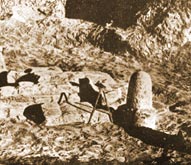
In 1940, MS Vats discovered six Shiva Lingas at Harappa. This is an archival photo of one linga. Lingam, grey sandstone in situ, Harappa, Trench Ai, Mound F, Pl. X (c) (After Vats). "In an earthenware jar, No. 12414, recovered from Mound F, Trench IV, Square I... in this jar, six lingams were found along with some tiny pieces of shell, a unicorn seal, an oblong grey sandstone block with polished surface, five stone pestles, a stone palette, and a block of chalcedony..." (Vats, EH, p. 370)
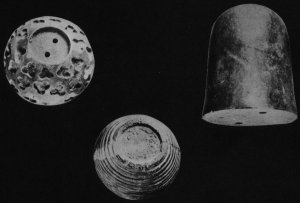 Two decorated bases and a lingam, Mohenjodaro.
Two decorated bases and a lingam, Mohenjodaro. 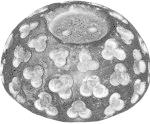 Tre-foil inlay decorated base (for linga icon?); smoothed, polished pedestal of dark red stone; National Museum of Pakistan, Karachi; After Mackay 1938: I, 411; II, pl. 107:35; Parpola, 1994, p. 218.
Tre-foil inlay decorated base (for linga icon?); smoothed, polished pedestal of dark red stone; National Museum of Pakistan, Karachi; After Mackay 1938: I, 411; II, pl. 107:35; Parpola, 1994, p. 218.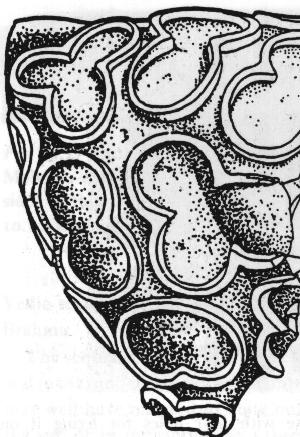 Steatite statue fragment; Mohenjodaro (Sd 767); trefoil-decorated bull; traces of red pigment remain inside the trefoils. After Ardeleanu-Jansen 1989: 196, fig. 1; Parpola, 1994, p. 213.
Steatite statue fragment; Mohenjodaro (Sd 767); trefoil-decorated bull; traces of red pigment remain inside the trefoils. After Ardeleanu-Jansen 1989: 196, fig. 1; Parpola, 1994, p. 213.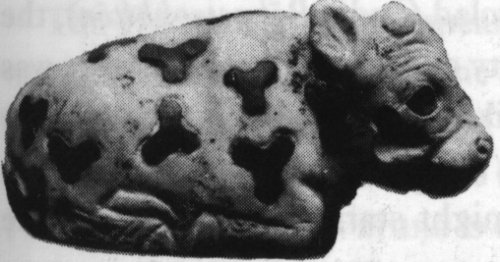 Statue, Uruk (W.16017), c. 3000 B.C.; bull with trefoil inlays; shell mass with inlays of lapis lazuli; 5.3 cm. long; Vorderasiatisches Museum, Berlin; Parpola, 1994, p. 213.
Statue, Uruk (W.16017), c. 3000 B.C.; bull with trefoil inlays; shell mass with inlays of lapis lazuli; 5.3 cm. long; Vorderasiatisches Museum, Berlin; Parpola, 1994, p. 213.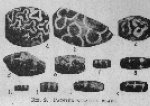 Trefoils painted on steatite beads, Harappa (After Vats, Pl. CXXXIII, Fig.2)
Trefoils painted on steatite beads, Harappa (After Vats, Pl. CXXXIII, Fig.2)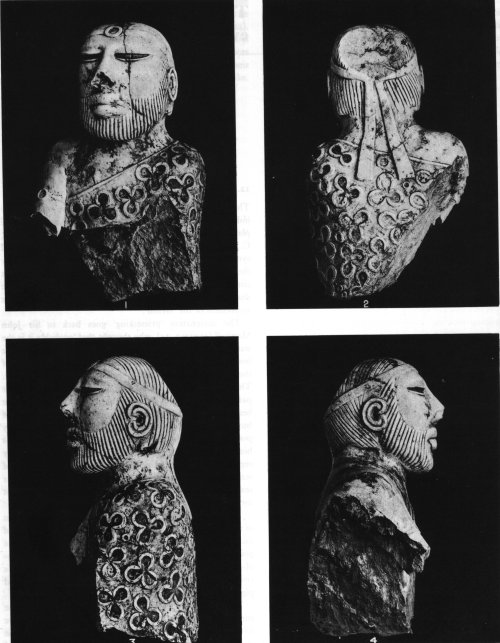 Statue (DK 1909), Mohenjodaro; four views; white steatite, with remnants of red paint inside the trefoils of the robe; height 17 cm.; National Museum of Pakistan, Karachi; After Marshall 1931a:pl.98; Parpola, 1994, p. 212.
Statue (DK 1909), Mohenjodaro; four views; white steatite, with remnants of red paint inside the trefoils of the robe; height 17 cm.; National Museum of Pakistan, Karachi; After Marshall 1931a:pl.98; Parpola, 1994, p. 212.Trefoil decorations associated with the 'priest' statue, 'bull/calf statue' and 'lingam' base are indicative of the possibility that the Bharatam Janam of Harappa and Mohenjo-daro and in Meluhha settlements of Uruk held the aniconic form of lingam in veneration, pointing to an aadhyaatmika gestalt in those early Bronze-age times. Rebus readings have been dealt with elsewhere using Meluhha glosses relatable to the hieroglyphs of bull, bull-calf and priest. (e.g. trilogy of S. Kalyanaraman (2010, 2014); see:
https://www.academia.edu/9643316/A_review_of_Dr_S._Kalyanaraman_s_trilogy_by_Dr_Shrinivas_Tilak).
See: http://bharatkalyan97.blogspot.in/2015/01/sekkizhar-periya-puranam-candi-sukuh.html
http://bharatkalyan97.blogspot.in/2015/01/stepped-socles-of-assur-meluhha.html
Siva linga was metaphored as pillar of light, consistent with the Atharvaveda Skambhasukta.
S. Kalyanaraman
Sarasvati Research Center
February 12, 2015













